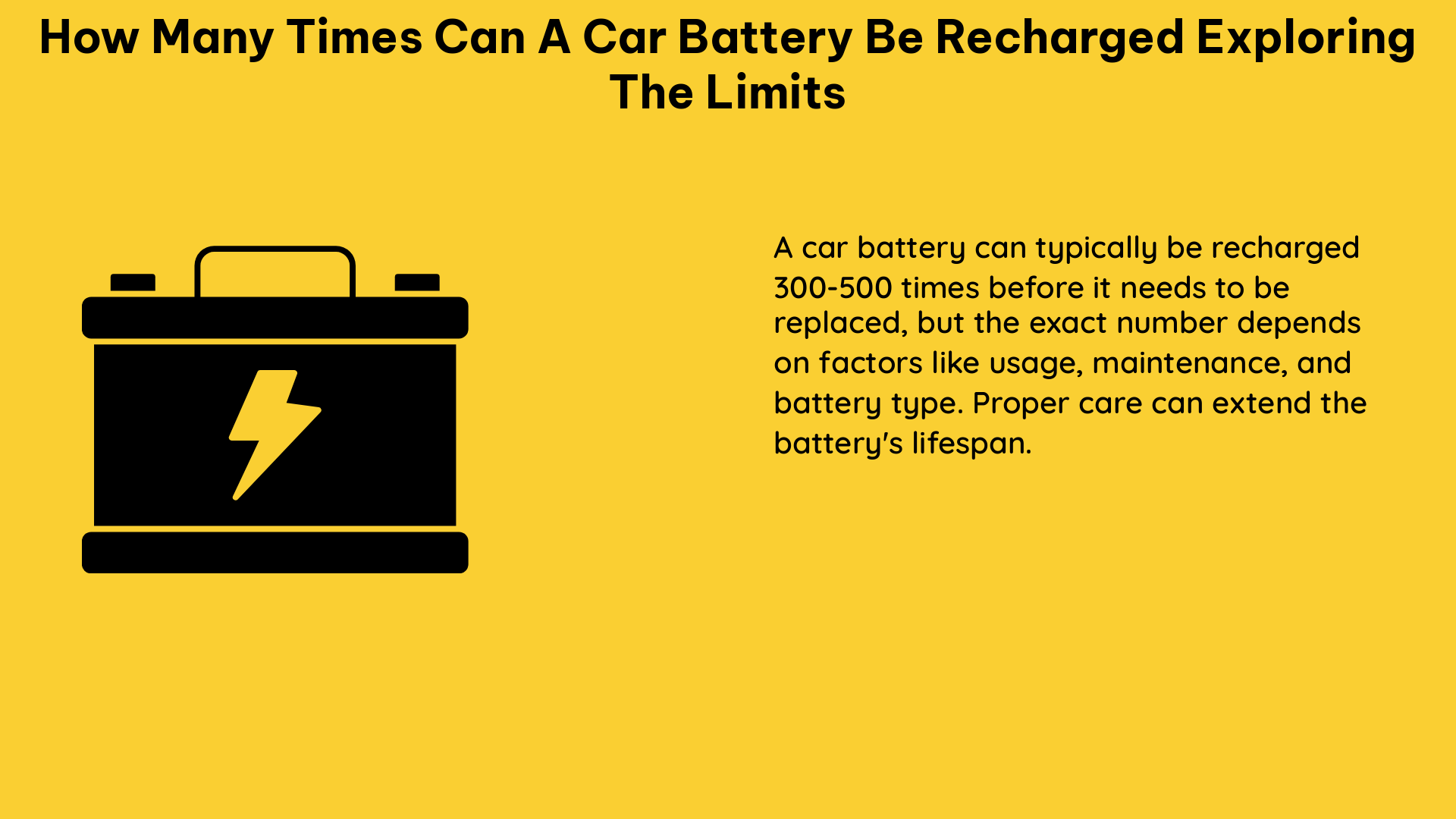The number of times a car battery can be recharged depends on various factors, including the type of battery, its capacity, and the charging conditions. Understanding these factors is crucial for maximizing the lifespan and performance of your car’s battery.
Lead-Acid Batteries: Charging at the Optimal Rate
For a standard 12V lead-acid car battery with a capacity of around 80Ah, the general rule of thumb is to charge it at a rate of C/10, where C is the battery capacity in ampere-hours (Ah). This means that for an 80Ah battery, the recommended charging current would be 8A (80Ah / 10 = 8A).
However, it’s important to note that charging at higher currents can shorten the battery’s lifespan. For instance, charging a 12V battery at 33A (as in the case of a 400W charger) might be too aggressive and could potentially harm the battery over time. This is because higher charging currents generate more heat, which can degrade the battery’s internal components and reduce its overall capacity.
To maximize the number of recharge cycles for a lead-acid battery, it’s recommended to adhere to the following guidelines:
- Charge at C/10 or lower: Charging the battery at a rate of C/10 or lower helps to minimize heat generation and ensures a gentle, controlled charging process.
- Avoid deep discharges: Regularly discharging the battery to very low levels (below 50% state of charge) can shorten its lifespan. Try to keep the battery within the 20-80% state of charge range whenever possible.
- Use a quality charger: Invest in a high-quality battery charger that can accurately monitor the battery’s voltage and current during the charging process. This helps to ensure a safe and efficient charging cycle.
- Monitor battery temperature: Keep an eye on the battery’s temperature during charging, and stop the charging process if the temperature exceeds the manufacturer’s recommended limits.
By following these guidelines, you can typically expect a lead-acid car battery to be recharged between 300 to 500 times before it needs to be replaced.
Lithium-Ion Batteries: Optimizing Charging for Longevity

When it comes to lithium-ion batteries, such as those found in electric vehicles (EVs), the recommended charging range is typically between 20% and 80% of the battery’s capacity. This approach helps maintain the battery’s health and longevity.
Charging beyond 80% is generally not necessary for daily driving, and doing so unnecessarily can stress the battery. For instance, a Kona Electric with an 80% charging limit for daily driving would only need to be charged once every two to three weeks.
To maximize the number of recharge cycles for a lithium-ion battery, consider the following guidelines:
- Charge within the 20-80% range: Avoid regularly charging the battery to 100% or allowing it to discharge below 20%. This helps to minimize stress on the battery and preserve its overall capacity.
- Use a dedicated EV charger: EV chargers are designed to manage the charging process efficiently and safely for lithium-ion batteries. Avoid using generic chargers, as they may not have the necessary safeguards.
- Limit fast charging: While fast charging can be convenient, it generates more heat and can accelerate battery degradation. Use fast charging sparingly and opt for slower, overnight charging whenever possible.
- Monitor battery temperature: Like lead-acid batteries, keep an eye on the lithium-ion battery’s temperature during charging and avoid charging in extreme temperatures.
With proper care and charging practices, lithium-ion batteries in EVs can typically be recharged between 1,000 to 2,000 times before their capacity starts to noticeably decline.
Factors Affecting Battery Lifespan
In addition to the charging conditions, several other factors can influence the number of times a car battery can be recharged:
- Battery chemistry: Different battery technologies, such as lead-acid, lithium-ion, or lithium-polymer, have varying recharge capabilities and lifespans.
- Battery capacity: Batteries with higher capacities (measured in Ah) generally have a longer lifespan and can be recharged more times than lower-capacity batteries.
- Operating temperature: Extreme temperatures, both hot and cold, can accelerate battery degradation and reduce the number of recharge cycles.
- Depth of discharge: Regularly discharging the battery to very low levels (below 20% state of charge) can shorten its lifespan.
- Maintenance and care: Proper maintenance, such as regular cleaning, terminal tightening, and avoiding overcharging, can help extend the battery’s lifespan.
By understanding these factors and following the recommended charging practices, you can maximize the number of times your car battery can be recharged and enjoy a longer-lasting, more reliable power source for your vehicle.
Conclusion
The number of times a car battery can be recharged depends on a variety of factors, including the battery type, capacity, charging conditions, and overall maintenance. By adhering to the guidelines outlined in this article, you can extend the lifespan of your car’s battery and ensure it continues to provide reliable power for your vehicle.
Remember, regular maintenance, proper charging practices, and a keen eye on battery health are the keys to maximizing the number of recharge cycles and getting the most out of your car’s battery.
Reference:
– What amount of current should I use to charge a 12V car battery?
– What do you let your battery get to before charging?
– Debunking the 80-20 limits on EV battery charging: more FUD from fossil fuel industry

The lambdageeks.com Core SME Team is a group of experienced subject matter experts from diverse scientific and technical fields including Physics, Chemistry, Technology,Electronics & Electrical Engineering, Automotive, Mechanical Engineering. Our team collaborates to create high-quality, well-researched articles on a wide range of science and technology topics for the lambdageeks.com website.
All Our Senior SME are having more than 7 Years of experience in the respective fields . They are either Working Industry Professionals or assocaited With different Universities. Refer Our Authors Page to get to know About our Core SMEs.